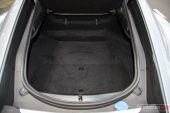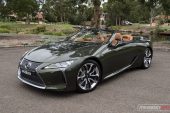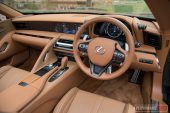Looking to spend around $200k on a sexy sports car, and require something that’s not only fast but also sounds sensation and offers good practicality for everyday use? The 2021 Jaguar F-Type P380 and Lexus LC 500 convertible could be right down your alley.

Yes, we know. These two are not perfect direct competitors. Not in this specification anyway. Ideally, we should be comparing the F-Type convertible with the V8 option to this Lexus LC 500 convertible. In any case, we’re going to try and look at these two as a nameplate in general, as well as hone in on the specs. Because after all, they both, in this specification, offer a claimed 0-100km/h time of 4.9 seconds each, and feature exactly the same power-to-weight ratio.
The Federal Chamber of Automotive Industries in Australia puts these two in the same ‘Sports car above $80k’ vehicle segment. They’re actually closer to the flagship ‘above $200k’ segment. Prices for the latest F-Type start from $128,066 for the 2.0T four-cylinder coupe, while this P380 supercharged V6 coupe starts from $174,765 ($193,466 for the convertible).
From Japan, the Lexus LC range starts from $194,757 for the 500 (V8) coupe, with the convertible asking $214,000. There is no entry level version of the LC, only a V6 hybrid coupe (called LC 500h) which is about 500 bucks more than the V8 coupe. (All prices exclude on-road costs.)
2021 Jaguar F-Type P380 Coupe – THE SPECS
[column width=”47%” padding=”6%”]Engine: 3.0-litre supercharged V6
Output: 280kW@6250rpm / 460Nm@4500-5000rpm
Transmission: Eight-speed auto
Drive type: Rear-wheel drive, limited-slip differential
Wheels: F: 20×9.0, 255/35 R: 20×10.5, 295/30
ANCAP: Not tested
Tare weight: 1594kg
Power-to-weight: 5.69:1 (kg:kW)
Official fuel economy: 8.6L/100km
Economy during test: 12.2L/100km[/column] [column width=”47%” padding=”0″]Fuel capacity/Type: 70L/95 RON
Power efficiency: 32.55kW:L/100km
0-60km/h: 2.65 seconds*
0-100km/h: 4.88 seconds*
60-110km/h: 2.99 seconds*
1/4 mile: 13.13 seconds at 177.5km/h*
Max acceleration: 0.763g
100-0km/h braking: 36.74 metres*
Max deceleration: -1.218g
Decibel at idle (/Sport mode): 47/49*
Peak decibel at 60-100km/h: 90*
Priced from: $174,765[/column][end_columns]
2021 Lexus LC 500 Conversion – THE SPECS
[column width=”47%” padding=”6%”]Engine: 5.0-litre V8
Output: 351kW@7100rpm / 540Nm@4800rpm
Transmission: 10-speed auto
Drive type: Rear-wheel drive, limited-slip differential
Wheels: F: 21×8.5, 245/40 R: 21×9.5, 275/35
ANCAP: Not tested
Tare weight: 2000kg
Power-to-weight: 5.69:1 (kg:kW)
Official fuel economy: 12.7L/100km
Economy during test: 14.5L/100km[/column] [column width=”47%” padding=”0″]Fuel capacity/Type: 82L/98 RON
Power efficiency: 27.63kW:L/100km
0-60km/h: 2.83 seconds*
0-100km/h: 5.37 seconds*
60-110km/h: 3.37 seconds*
1/4 mile: 13.46 seconds at 178.5km/h*
Max acceleration:x0.753g
100-0km/h braking: 38.29 metres*
Max deceleration: -1.381g
Decibel at idle: 46*
Peak decibel at 60-100km/h: 93*
Priced from: $214,000[/column][end_columns]
* Figures as tested by PerformanceDrive on the day. Factory claims may be different
2021 Jaguar F-Type P380 vs Lexus LC 500 – THE PACKAGE
Starting with the Jaguar. It recently received a design facelift so now it looks sleeker than before, with pinched headlights and a wider-opening front grille for increased on-road presence. It looks more purposeful in our opinion, but it may have lost some of the charm of the first F-Type. You still get a long and imposing bonnet, with the cabin set behind the centre point, following a tradition set by the classic E-Type.
Fortunately, the same sexy curves carry over as well, including the huge rear haunches. The front-to-rear width ratio is actually more pronounced in the F-Type compared with many other sports cars, even the Porsche 911. It’s fat.
Going for the V6 variant means you get twin centrally-mounted exhausts, which we think look way cooler than the outboard exhausts on the V8 model. The P380 V6 comes with staggered wheel sizes front and rear for that dynamic and sporty setup, with 255/35 tyres on the front, and whopping 295/30s on the back. Jaguar chooses Pirelli P Zero while Lexus uses Michelin Pilot Super Sport.
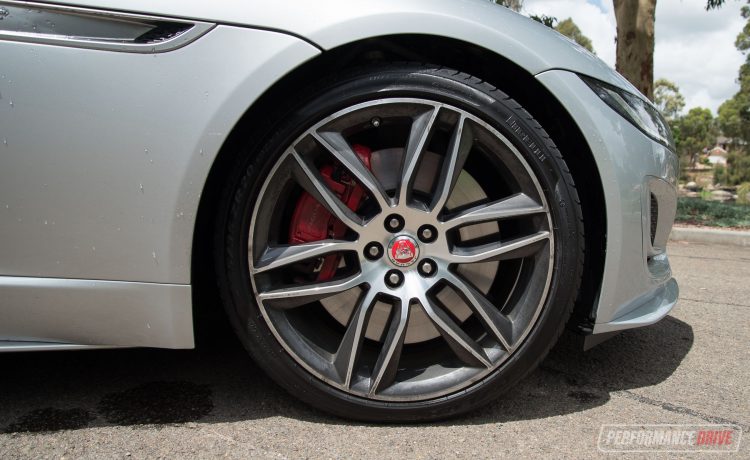
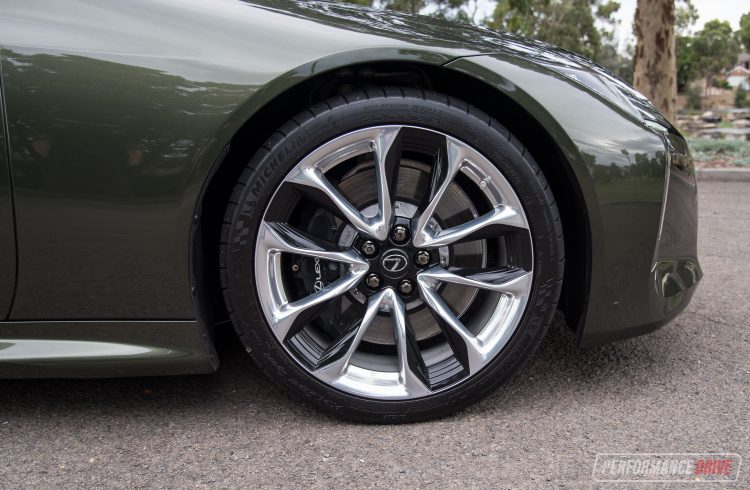
As for the Lexus, it is definitely a more extravagant design. During our test we noticed this example turned more heads than the Jaguar. But part of that is probably due to it being a convertible, and a newer model. The green and tan colour combination also stands out against the smart and sophisticated silver Jag.
They both might look pretty big on screen/paper, but in the metal they are actually quite small and very low. At 4770mm long, the Lexus is 300mm longer than the F-Type though, but the F-Type is 3mm wider. The F-Type also sits 39mm lower in terms of roof height. With a wheelbase of 2870mm, the Lexus has room to sneak in some rear seats, while the Jag’s 2622mm wheelbase can’t really cater for that.
All LC models are rear-wheel drive, and this V8 example features stunning 21-inch alloy wheels, wrapped in 245/40 front and 275/35 rear tyres. The fact the tyres are not quite as wide as those on the Jag gives you some clues of the handling characteristics. More on that later.

Jaguar hasn’t really done that much with interior for the new model. It’s still a nice driver’s office, with a new touch-screen interface mounted on the driver-focused dash. A beam/grab handle supports the passenger-side of the dash fascia on both vehicles, interestingly. We still love the little digital screens for the climate controls on the Jag, carried over from the previous model. We also like the very low and hunkered-down seating position.
A fully digital instrument cluster replaces the old mechanical gauges to add a touch of modernity. Two dials now surround a configurable centre display, allowing you to toggle between things such as a sat-nav map display or four quadrants of trip data. The screen does help boost the F-Type’s appeal, especially against the tech-heavy Lexus. In saying that, we also liked the old mechanical gauges that Jag had, with their intricate needles.

If you’re looking for storage space, the Jaguar is the winner. There is limited storage around the cabin, with a shallow centre armrest/box, two cup holders, and very narrow door pockets. However, since the F-Type is not available with four seats, there is heaps of room left for a decent boot. Without the space-saver spare wheel option the specs indicate 509L of volume. The big hatch lid helps when loading and unloading items, too.
Like the exterior, Lexus is clearly going for wow factor with its interior. And honestly, it is breathtaking. Over-the-top? Maybe. But if you’re spending this much on a car maybe you want over-the-top? All of the controls and switchgear have a pleasingly solid and high-quality feel to them, and the materials throughout are top notch.

We love the way the dash flows and wraps around with the door trim, and as usual with Lexus vehicles, you get lush, deep carpet mats. This, in our opinion, is a more luxurious vehicle than the F-Type. That’s not necessarily a good thing as this segment is also about sportiness. But compared with the Jaguar, Lexus has done a better job of making this feel and look very expensive.
Unfortunately, Lexus is persisting with its very fiddly and, frankly, annoying touch pad controller system for the media interface. It’s just too cumbersome to use while trying to drive, and needlessly complicated. Like we’ve said before, it is a great piece of technology that Lexus can show off with pride… in a concept car. But for practical use, in a road car, it needs to go. Other than that it is hard to complain about this interior.
The LC 500 does feature two rear seats but there is very limited legroom available. Even if you never use them though, they do seem to open up the cabin atmosphere and make it feel bigger (when the roof is up). The seats can also be used for storage. Speaking of which, the LC convertible offers just 149L of boot space. Even the LC 500 coupe, which presents 197 litres, can’t match the Jag.
2021 Jaguar F-Type P380 vs Lexus LC 500 – THE DRIVE
At the pointy end, the Jaguar’s 3.0-litre supercharged V6 can’t match the belting power level of the V8 in the Lexus. The long-running AJ-based unit has been revised for the new F-Type, producing a carry-over 280kW and 460Nm. However, we notice peak torque now spreads 4500-5000rpm instead of 3500-5500rpm in the superseded model. We’re not sure why that is.
Peak power is now reached at 6250rpm as well, down from 6500rpm. These minor changes haven’t made any difference in fuel economy, with the same 8.6L/100km rating carrying over and the same emissions rating of 203g/km. However, the latest consumption rating, even though it is the same figure, could be under the newer WLTP testing protocol which is designed to provide a more real-world guide.
Over in the Lexus is undoubtedly one of the greatest-sounding V8s of all time. Have a listen to it in the video below. It is such a glorious and empowering soundtrack, transitioning from a deep baritone gargle into a metallic, jack-hammering roar as it passes 7000rpm. These types of engines won’t be around for much longer. Not in raw, naturally aspirated form. Lexus really needs to be applauded for continuing to use mechanical tuning for finding its performance, rather than ‘cheating’ with forced induction like so many rivals.

The engine, codenamed 2UR-GSE, is likely at its peak for a production Lexus. From here, the company is set to switch to hybridisation, and there has been confirmation of a new twin-turbo V8 in the works. For now though the 2UR develops 351kW at an ear-massaging 7100rpm, with 540Nm of torque available at 4800rpm. There is no big torque window here. This is brute grunt. If you want it, let it know.
Obviously one of the main reasons carmakers opt for forced induction is for efficiency. So, as no surprise, the V8 Lex’ chews more fuel than the Jag. The official consumption average is 12.7L/100km, up from 11.6L/100km in the LC 500 coupe. The emissions output is 290g/km, which is quite high for today’s, and in particular, the near-future’s standards. For example, even the optional 5.0-litre supercharged V8 in the Jaguar, which belts out over 400kW, emits 267g/km and has an average consumption rating of 11.3L/100km (coupe).

Out on the road you can feel the Jaguar’s more immediate response and low-end torque. And there is one major factor that helps here; weight. Or lack thereof. According to Redbook data this F-Type has a tare mass of 1594kg. That’s over 400kg lighter than the LC 500 convertible’s tare weight of 2000kg. Even the LC 500 coupe is 300kg away, weighing 1910kg. For the Jaguar, being light helps in every department, including handling dynamics, agility, and of course, performance.
Although both manufacturers claim 0-100km/h is done and dusted in 4.9 seconds, we struggled to see anything under 5.0 in the Lexus during our tests, using a Racelogic Vbox Sport. In fact, the best we achieved (from around five different runs) was 5.37 seconds. In similar conditions the Jaguar scorched the sprint in an easy 4.88 seconds. They’re both very quick machines nonetheless, especially if you characterise them as grand touring sports cars rather than hardcore, track-ready vehicles. But the Jaguar is a great lesson in why forced induction works and why weight doesn’t.
Interestingly, and perhaps expectedly, the Lexus offers superior top-end speed. After all, it does develop around 70kW more power. On a private road we clocked 0-200km/h in 17.18 seconds in the Lexus, while the Jaguar P380 tapered off once the speed reached around 180km/h, resulting in a time of 17.46 seconds. The 1/4 mile was crossed in 13.13 seconds at 177.5km/h in the Jag, and 13.46 seconds at 178.5km/h in the Lexus. Again, the trap speed reflects the sheer horsepower and torque of the almighty V8.

In terms of handling, there is a clear distinction between these two. The Jaguar is unquestionably a better-handling machine. That is, in regards to potential cornering speed, stability, and power-down grip (helped by those 295 rear tyres). It feels very nimble and loves to dart between switch-backs and tighter S-bends. And it feels extremely solid and planted on the tarmac.
In contrast, the Lexus more closely resembles a boat. A speed boat, but a boat nonetheless. In comparison that is. On its own it is a wonderful-handling open-top sports car. The suspension is softer, so it is definitely more comfortable, and the transitions are slower making it feel slightly more predictable, albeit not as sharp. You can feel the extra weight, too, particularly when carrying speed through tighter corners. However, it glides around majestically when you’re not maxing it out, and it is beautifully smooth and progressive. Perhaps surprisingly, the Lexus can be the most playful of the two, providing more flexibility and forgiveness when testing the limits of tyre adhesion.
Overall, both of these cars are a hoot to drive. They stimulate the senses like sports cars are supposed to, in a number of ways, and they are more than capable enough to facilitate a blast down your favourite road. Just keep in mind the Jaguar is a bit more serious – both good and bad, depending on what you’re after – while the Lexus is more of an entertainer in that it is more about the sound and style.
2021 Jaguar F-Type P380 vs Lexus LC 500 – THE VIDEO
2021 Jaguar F-Type P380 vs Lexus LC 500 – THE VERDICT
Both of these cars are thoroughly admirable in many ways, there is no doubt about that. And they both offer a lot of character, albeit in a unique direction. You’ve probably heard us say this before but it is genuinely difficult to pick an outright winner here. So, we’ll just leave it with this. If you live in the mountains and regularly journey up and down, or along, a tight and twisty road, go for the Jaguar. It is the better driver’s car in our opinion. It’s sharper, more precise, and more rewarding when you get it right. And it’s quicker. On the other hand, if you live near a coastal road and enjoy cruising the esplanade, the Lexus is the pick. It looks stunning, is more comfortable, sounds sensational, and even has rear (although very tight) seats.
As a footnote, we are going to apply some ‘demerit points’ to Jaguar following its announcement that it will make only electric vehicles from 2025. That means the next F-Type, if there is one, will be silent. And that doesn’t sit right with us at all. We think it is very sad news, especially from a brand that carries such an extensive and well-respected heritage in sports cars and motorsport, and building desirable sports car engines.
As always, if you’re thinking about buying a new car don’t forget to click here to speak with our car buying specialists.


















